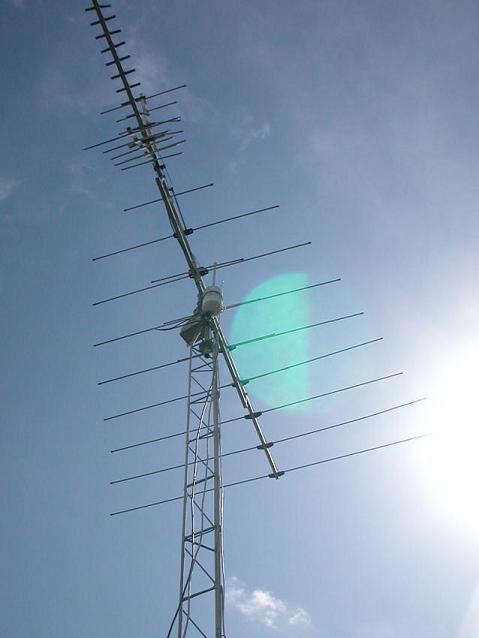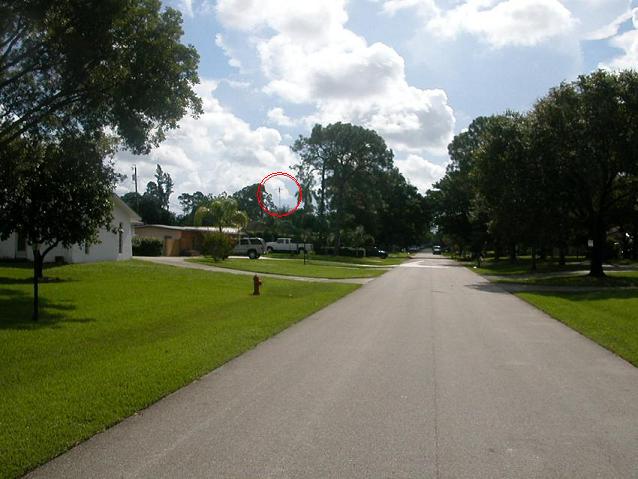Testing the Range of the SMC2655W
Getting It Up
I had been wanting to do some "testing" with the
external antenna and enclosure I had built. I say
"testing", because testing usually involves a plan and a clear set
of goals and measurements. I just wanted to see what kind of range
I could get.
When Darren offered the use of his crank-up antenna I jumped at it.
He said it would get about 35 feet in the air. He was interested in
using 802.11b to share DSL with his neighbor across the street, or
possibly using an antenna to provide DSL-over-wireless to some nearby
neighbors. The question was, how nearby did they have to be?
Darren doesn't do heights, so he held the ladder while I went up on
the roof.

I had to remove the clamp holding the crank-up antenna from
moving, and attach the wireless antenna to the top.
Darren cranked down the antenna, and I used cable ties to secure the
wireless antenna to the top of the mast. The gray cable hanging down
is the ethernet cable carrying Power over Ethernet on an unused pair.

Darren got the cables connected down below.
There wasn't much. I had brought a small Belkin router to act as a
DHCP server. Darren powered that up, then plugged the cable from the
wireless antenna into the router, and then powered up the wall wart
that supplies power to the PoE injector. Everything, theoretically,
was working.


Now he got busy cranking. Here is the antenna in its fully extended
position, with the white wireless antenna at the top. It doesn't look
that high, but remember that I was standing on the roof when I took the
picture. It's 15 or 20 feet from the roof peak where I am, to the
ground.

Here's a shot from down the street giving a better idea of how high
the wireless antenna is.

Checking It Out
We walked down the street with a Dell Axim Pocket PC, with a Linksys
Compact Flash wireless card. I used the client software from Linksys
to see what the signal strength was. It updates every second or so,
so you get a good idea of what the strength is everywhere. You can
see the antenna again in the background behind me.

I brought along a handheld GPS. I set a waypoint at Darren's house
next to the antenna,
and then set the GPS to give a bearing and distance back to the
waypoint. This way as we walked along we knew how far we were from
the antenna. We got a solid usable signal (about 20%) out to 0.1
miles (528 feet). We got an intermittent signal up to 0.2 miles
(1056 feet). That was line of sight; the trees really killed the
signal.

One of Darren's next-door neighbors let us come into his house and
check signal strength there. I got 20% to 33%, easily enough to
handle the bandwidth of a DSL connection. It was a concrete house,
but it took me a while to understand that the house was not built
of concrete block, but was actually a poured concrete house. I think
the signal was really coming through the roof from the antenna high
overhead next door. No other neighbors were home to let us try their
houses.
So it was time to go mobile.

We loaded up the Toshiba notebook with an Orinoco wireless card and a
5dBi magmount antenna on the roof. The GPS was on the dash, and we
had the Pocket PC for backup. The results were pretty consistent with
what we had seen before: usable signal up to 0.1 miles, intermittent
signal up to 0.2 miles. We also did a little checking to see if any
of Darren's neighbors had open APs so he could get out on their DSL,
but it had been so long since I went wardriving that I didn't have
netstumbler on this notebook.
Instead we had to use
pocket warrior on the Pocket PC. With the small built-in antenna
in the CF card we didn't get much signal, and only saw a couple APs
with "default" SSID that were too far from the house. It might be
possible to pick the APs up with a directional antenna, but probably
not.
Writing It Down
So we went back to house and took down the antenna before the lightning
storm hit. We sat around and considered options. Darren's neighbor
has a Windows XP box with an internal USB DSL modem. This means that
the Windows XP box would have to be on for Darren to use an AP
connected to it. One possible alternative would be an all-in-one
wireless DSL router, which would connect to BellSouth, provide AP
functionality to make the DSL available over wireless, and allow the
XP box to plug into the router via ethernet cable. Of course, those
boxes cost $200. Since Darren is familiar with building PCs, he might
be able to fake it by putting the USB DSL modem into a quiet little
PC, and connect the PC to a wireless router to connect to his neighbor,
and to Darren. In either case, the wireless router would use a
directional antenna in his neighbor's window, and on Darren's roof or
window.
Another option would be for Darren to get his own DSL, and put an
omnidirectional antenna like the one we tested on his roof. Then he
could sell DSL service to his neighbors cheaply to defray his costs.
The DSL bandwidth should be enough to handle everyone within range.
This would completely violate the Terms Of Service agreement with
BellSouth, but it's technically possible.
It was an educational day. Next I want to get the antenna mounted at
my house, and see if my neighbors can hit it.